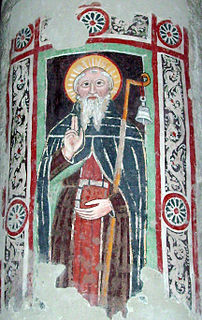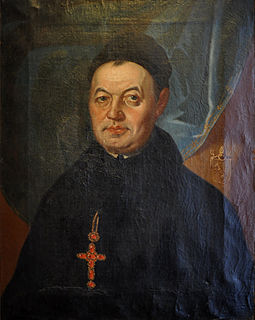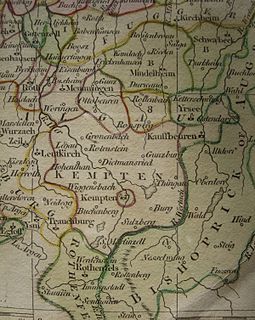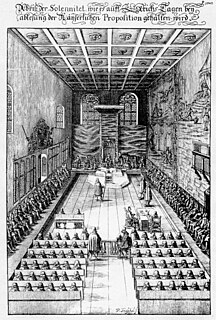
The Holy Roman Empire, occasionally but unofficially referred to as the Holy Roman Empire of the German Nation, was a multi-ethnic complex of territories in Western and Central Europe that developed during the Early Middle Ages and continued until its dissolution in 1806 during the Napoleonic Wars. The largest territory of the empire after 962 was the Kingdom of Germany, though it also included the neighboring Kingdom of Bohemia and Kingdom of Italy, plus numerous other territories, and soon after the Kingdom of Burgundy was added. However, while by the 15th century the Empire was still in theory composed of three major blocks – Italy, Germany, and Burgundy – in practice, the links between these blocks had become so unsubstantial that only the Kingdom of Germany remained, nearly all the Italian territories for instance having become in effect part of a narrowly-defined Habsburg dynastic patrimony, unconnected to the Empire. The external borders of the Empire did not change noticeably from the Peace of Westphalia – which acknowledged the exclusion of Switzerland and the Northern Netherlands, and the French protectorate over Alsace – to the dissolution of the Empire. By then, it largely contained only German-speaking territories, plus the Kingdom of Bohemia. At the conclusion of the Napoleonic Wars in 1815, most of the Holy Roman Empire was included in the German Confederation.

Regensburg is a city in south-east Germany, at the confluence of the Danube, Naab and Regen rivers. With more than 150,000 inhabitants, Regensburg is the fourth-largest city in the State of Bavaria after Munich, Nuremberg and Augsburg. The city is the political, economic and cultural centre and capital of the Upper Palatinate.

In the Holy Roman Empire, the collective term free and imperial cities, briefly worded free imperial city, was used from the fifteenth century to denote a self-ruling city that had a certain amount of autonomy and was represented in the Imperial Diet. An imperial city held the status of Imperial immediacy, and as such, was subordinate only to the Holy Roman Emperor, as opposed to a territorial city or town which was subordinate to a territorial prince – be it an ecclesiastical lord or a secular prince.

The Prince-Archbishopric of Salzburg was an ecclesiastical principality and state of the Holy Roman Empire. It comprised the secular territory ruled by the archbishops of Salzburg, as distinguished from the much larger Catholic diocese founded in 739 by Saint Boniface in the German stem duchy of Bavaria. The capital of the archbishopric was Salzburg, the former Roman city of Iuvavum.

An Imperial State or Imperial Estate was a part of the Holy Roman Empire with representation and the right to vote in the Imperial Diet. Rulers of these Estates were able to exercise significant rights and privileges and were "immediate", meaning that the only authority above them was the Holy Roman Emperor. They were thus able to rule their territories with a considerable degree of autonomy.

Saint Wolfgang of Regensburg was bishop of Regensburg in Bavaria from Christmas 972 until his death. He is a saint of the Roman Catholic and Eastern Orthodox churches. He is regarded as one of the three great German saints of the 10th century, the other two being Saint Ulrich and Saint Conrad of Constance. Towards the end of his life Wolfgang withdrew as a hermit to a solitary spot, in the Salzkammergut region of Upper Austria. Soon after Wolfgang's death many churches chose him as their patron saint, and various towns were named after him.

The Principality of Regensburg was a principality of the Holy Roman Empire created in 1803; following the dissolution of the Empire in 1806, it was part of the Confederation of the Rhine until 1810. Its capital was Regensburg.

Rupert of Salzburg was Bishop of Worms as well as the first Bishop of Salzburg and abbot of St. Peter's in Salzburg. He was a contemporary of the Frankish king Childebert III. As bishop at Worms, Rupert was at first accepted as a wise and devout dignitary, however, the mostly pagan community eventually came to reject him and forced him out of the city. By the end of the 7th century, the Agilolfing duke Theodo of Bavaria requested that he come to his residence at Regensburg (Ratisbon) to help spread the Christian faith among the Bavarian tribes. Rupert is venerated as a saint in the Roman Catholic and Eastern Orthodox Churches. Rupert is also patron saint of the Austrian state of Salzburg.

German mediatisation was the major territorial restructuring that took place between 1802 and 1814 in Germany and the surrounding region by means of the mass mediatisation and secularisation of a large number of Imperial Estates. Most ecclesiastical principalities, free imperial cities, secular principalities, and other minor self-ruling entities of the Holy Roman Empire lost their independent status and were absorbed into the remaining states. By the end of the mediatisation process, the number of German states had been reduced from almost 300 to just 39.

St. Emmeram's Abbey, now known as Schloss Thurn und Taxis, Schloss St. Emmeram, and St. Emmeram's Basilica, was a Benedictine monastery founded in about 739 in Regensburg in Bavaria at the grave of the itinerant Frankish bishop Saint Emmeram.

The Hiberno-Scottish mission was a series of missions and expeditions initiated by various Irish clerics and cleric-scholars who, for the most part, are not known to have acted in concert.

Princely abbeys and Imperial abbeys were religious establishments within the Holy Roman Empire which enjoyed the status of imperial immediacy (Reichsunmittelbarkeit) and therefore were answerable directly to the Emperor. The possession of imperial immediacy came with a unique form of territorial authority known as Landeshoheit, which carried with it nearly all the attributes of sovereignty.
The Prince-Bishopric of Regensburg was a small ecclesiastical principality of the Holy Roman Empire located near the Free Imperial City of Regensburg in Bavaria. It was elevated to the Archbishopric of Regensburg in 1803 after the dissolution of the Archbishopric of Mainz. The Prince-Bishopric of Regensburg must not be confused with the Roman Catholic Diocese of Regensburg, which was considerably larger.

The Prince-Bishopric of Bamberg was an ecclesiastical State of the Holy Roman Empire. It goes back to the Roman Catholic Diocese of Bamberg established at the 1007 synod in Frankfurt, at the behest of King Henry II to further expand the spread of Christianity in the Franconian lands. The bishops obtained the status of Imperial immediacy about 1245 and ruled their estates as Prince-bishops until they were subsumed to the Electorate of Bavaria in the course of the German Mediatisation in 1802.
Diet of Regensburg may refer any of the sessions of the Imperial Diet, Imperial States, or the prince-electors of the Holy Roman Empire which took place in the Imperial City of Regensburg (Ratisbon), now in Germany.

In the Holy Roman Empire, the German term Hochstift referred to the territory ruled by a bishop as a prince, as opposed to his diocese, generally much larger and over which he exercised only spiritual authority. The terms prince-bishopric and ecclesiastical principality are synonymous with Hochstift. Erzstift and Kurerzstift referred respectively to the territory ruled by a prince-archbishop and an elector-archbishop while Stift referred to the territory ruled by an imperial abbot or abbess, or a princely abbot or abbess. Stift was also often used to refer to any type of ecclesiastical principality.

The Princely Abbey of Kempten was an ecclesiastical principality of the Holy Roman Empire for centuries until it was annexed to the Electorate of Bavaria in the course of the German mediatization in 1803.

The Imperial Diet was the deliberative body of the Holy Roman Empire. It was not a legislative body in the contemporary sense; its members envisioned it more like a central forum where it was more important to negotiate than to decide.

The Prince-Bishopric of Freising was an ecclesiastical principality of the Holy Roman Empire from 1294 until its secularisation in the early years of the 19th century.
















